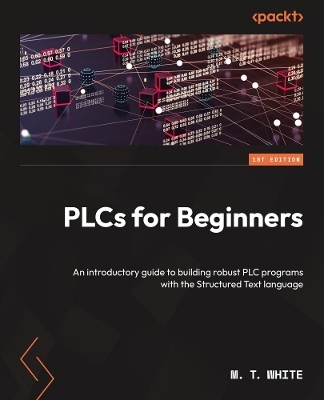
PLCs for Beginners
Packt Publishing Limited (Verlag)
978-1-80323-093-1 (ISBN)
Key Features
Unleash the power of structured text by understanding its syntax, features, and applications
Harness the power of programming logic and design by taking a design-first approach to PLC programming
Leverage advanced concepts and technologies such as cybersecurity and generative AI with PLC
Purchase of the print or Kindle book includes a free PDF eBook
Book DescriptionAs smart factories and advanced technology become more prevalent, the demand for PLC programmers with expertise beyond ladder logic is growing. This book introduces a new approach to PLC programming, preparing you for future challenges by exploring automation programming through computer science and text-based programming.
The book begins by exploring the basic components of PLCs and how they integrate with other modules, giving you a clear understanding of system functionality. As you progress, you'll delve into PLC program execution, learning about flow and essential components for effective programming. Next, you'll understand program design with pseudocode and flowcharts, vital for planning programs. You'll then explore Boolean logic intricacies, harnessing logical functions and truth tables for precise control statements. Later, you'll delve into structured text, gaining a comprehensive grasp of syntax and features crucial for efficient programming. The journey continues with a focus on advanced topics like cybersecurity in PLC systems and leveraging generative AI (GenAI), such as ChatGPT, to enhance productivity.
By the end of this book, you’ll be able to design real-world projects using pseudocode and flowcharts, and implement those designs in structured text.What you will learn
Explore and understand how to implement PLC programs in structured text
Experiment with common functions in structured text
Control the flow of a PLC program with loop and conditional statements
Discover how to design a PLC program with pseudocode and flowcharts
Implement common sorting algorithms such as bubble sort and insertion sort, and understand concepts such as Big O
Understand the basics of cybersecurity to protect PLC-based systems
Leverage ChatGPT for PLC programming
Understand the basics of troubleshooting hardware and fixing common problems
Who this book is forThis book is for automation engineering students and individuals seeking entry-level knowledge of PLC programming with structured text and other modern computer science concepts to excel in the advanced automation landscape. No prior knowledge of PLC programming is required.
M. T. White has been programming since the age of 12. His fascination with robotics flourished when he was a child programming microcontrollers. He holds an undergraduate degree in mathematics, a master's degree in software engineering, and an MBA in IT management. He is currently working as a software developer for a major US defense contractor and is an adjunct CIS instructor, where he teaches Python, C, and an array of other courses. His background mostly stems from the automation industry where he programmed PLCs and HMIs for many different types of applications. He has programmed many different brands of PLCs over the years and has developed HMIs using many different tools. Other technologies that he is fluent in include Linux, Ansible, Docker, AWS, C#, Java, and Python. Be sure to check out his channel AlchemicalComputing on YouTube.
Table of Contents
Computer Science Versus Automation Programming
PLC Components – Integrating PLCs with Other Modules
The Basics of Programming
Unleashing Computer Memory
Designing Programs – Unleashing Pseudocode and Flowcharts
Boolean Algebra
Unlocking the Power of ST
Exploring Variables and Tags
Performing Calculations in Structured Text
Unleashing Built-In Function Blocks
Unlocking the Power of Flow Control
Unlocking Advanced Control Statements
Implementing Tight Loops
Sorting with Loops
Secure PLC Programming – Stopping Cyberthreats
Troubleshooting PLCs – Fixing Issues
Leveraging Artificial Intelligence (AI)
The Final Project – Programming a Simulated Robot
| Erscheinungsdatum | 11.05.2024 |
|---|---|
| Verlagsort | Birmingham |
| Sprache | englisch |
| Maße | 191 x 235 mm |
| Themenwelt | Informatik ► Theorie / Studium ► Künstliche Intelligenz / Robotik |
| Technik ► Elektrotechnik / Energietechnik | |
| ISBN-10 | 1-80323-093-2 / 1803230932 |
| ISBN-13 | 978-1-80323-093-1 / 9781803230931 |
| Zustand | Neuware |
| Informationen gemäß Produktsicherheitsverordnung (GPSR) | |
| Haben Sie eine Frage zum Produkt? |
aus dem Bereich


